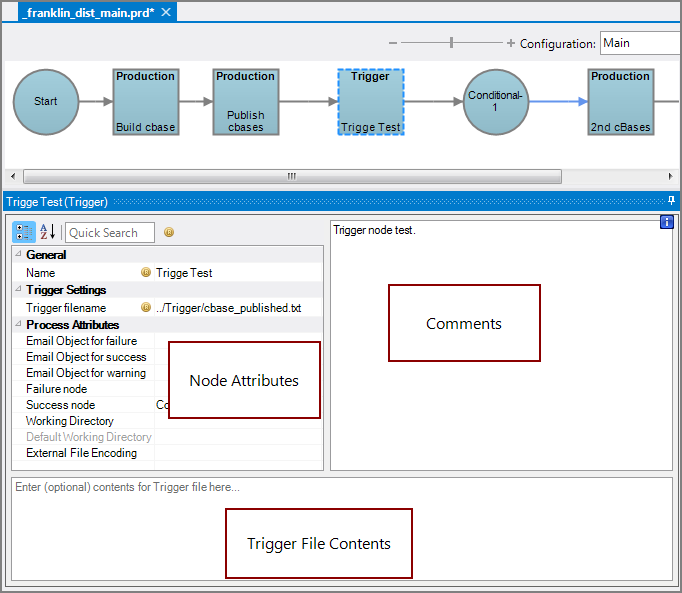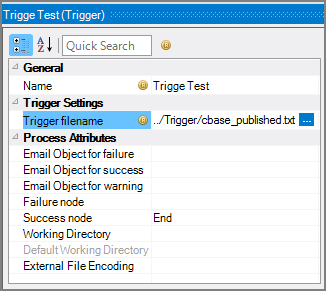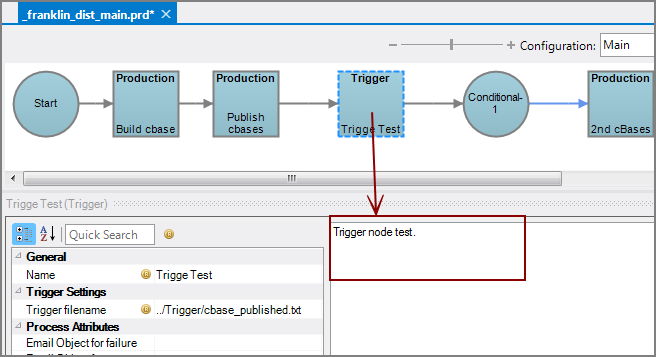A Trigger node is a Production process node that creates a Trigger file that is used in subsequent Conditional nodes.
![]()
The Trigger file can contain user-defined events that modify the behavior of any Conditional node that uses the Trigger file. In addition to user-defined events, the presence or absence of a defined Trigger file determines subsequent process flow.
The Trigger node has ![]() three panes where you set attributes and other details.
three panes where you set attributes and other details.
You set attributes for the Trigger node in the ![]() node attributes pane.
node attributes pane.
| Attribute | Description |
|---|---|
| Name | Specify a descriptive name for the node. Lower case names maximize usage of the available space. |
| Trigger filename (Required) |
Specify the path and name for the Trigger file. To select a file, use the browse button (...) that appears when you click in the empty Trigger filename box. Common file extensions are txt, trg, and lck. Optionally, you can enter the Trigger file contents in the Trigger file contents pane. |
| Email Object for failure |
Select a predefined mailing list to send an email to if the node fails. The pull-down list is populated with items that can be found in Project Settings > Mailing Lists > Email Templates. |
| Email Object for success |
Select a predefined mailing list to send an email to if the node succeeds. The pull-down list is populated with items that can be found in Project Settings > Mailing Lists > Email Templates. |
| Email Object for warning |
Select a predefined mailing list to send an email to if the node generates a warning. The pull-down list is populated with items that can be found in Project Settings > Mailing Lists > Email Templates. |
| Failure node | Select the next node upon failure. The pull-down list contains all nodes that are on the Task Flow. |
| Success node | Select the next node upon successful completion. The next node automatically populates if a connecting line is set on the Task Flow. The pull-down list contains all nodes that are on the Task Flow. |
| Working Directory |
Specifies the directory in which this node runs. If left blank, the Default Working Directory attribute that is set in the Start Control Node is used. When running a script, Production sets the working directory for the child process to the directory that contains the script, unless the node specifies a different directory. See Start Control Node. |
| Default Working Directory |
Displays the Default Working Directory that is set the the Start Control Node. If a Default Working Directory is not specified, this attribute is blank. Applies to all nodes. See Start Control Node. |
| External File Encoding |
Select the format for the node input files. If this attribute is blank, Workbench attempts to detect the type of encoding. This attribute is also used when saving log files. The encoding might need to be adjusted when using data with high bit Latin-1 characters or Unicode characters. |
Each node has an area where you can enter comments.
It is a DI best practice to enter a note for every node in a Production script. These notes can help you or a coworker understand the intent of the node and troubleshoot issues in the future.
You can optionally define the contents of the Trigger file in the ![]() Trigger file contents pane.
Trigger file contents pane.
The contents define the events that must occur before a Conditional node begins processing its defined tasks. For example: $(P_Minutes) indicates that a specified number of minutes must pass where a failure has not occurred before the Conditional node can begin processing.
See also Conditional Control Node.



